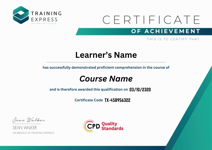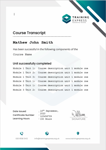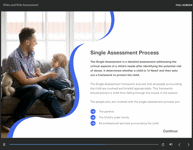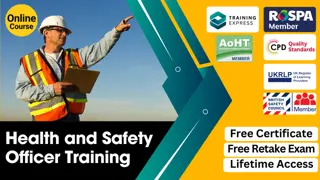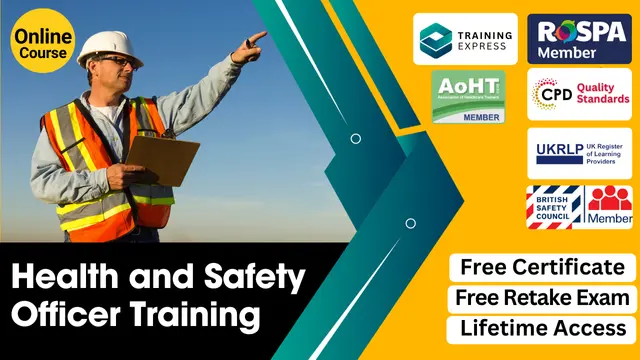
Health and Safety Officer Training Course
Diploma Level 3 | CPD Certificate | Free PDF Certificate | Free Retake Exam | Lifetime Access
Summary
- Digital certificate - Free
- Hard copy certificate - Free
- Exam(s) / assessment(s) is included in price
- Tutor is available to students
Add to basket or enquire
Overview
✩ Trusted by Over 10K Business Partners & 1 Million Students Around the World! ✩
[Updated 2025]
This course is designed to provide learners with an in-depth understanding and necessary knowledge and best practices, risk assessment, and relevant laws and regulations for a wide range of work settings on Health and Safety.
This comprehensive Health and Safety Officer Training course covers all aspects of workplace risks and welfare practices. It includes step-by-step guidance, case studies, and audiovisual materials, ideal for construction workers, factory workers, electricians, and other professionals working in high-risk environments.
This Health and Safety Officer Training course will teach you about risk assessment at workplaces, which includes electrical, gas, and fire safety. Also, you’ll learn about safe manual handling and how to ensure welfare while working at heights or in confined spaces.
By the end of the course, you will have the essential skills and knowledge to ensure you and your colleagues are working in compliance with the Health and Safety at Work Act 1974, taking the necessary precautions to minimise dangers and control hazards effectively.
Learning Outcomes
By the end of the course, learners will be able to:
- Health and safety regulations in the UK
- Different dangerss and hazards related to a wide range of work settings
- Identify dangers and take proper steps to ensure welfare by minimising the risk
- Conduct a detailed risk assessment plan
- Make the workplace safe and comply with Health and Safety at Work Act
- Costs and dangers of poor Health and Safety in the workplace
- Health hazards related to electricity and fire, and how to avoid such hazards
- Deal with minor injuries in the workplace and apply the basic first aid techniques
- Implement, control, and monitor a welfare management plan in the workplace
Key Features of This Course
- CPD Accredited Officer course
- Instant PDF certificate
- Fully online, interactive course with audio voiceover
- Developed by Officer professionals
- Self-paced learning and laptop, tablet, smartphone-friendly
- 24/7 Learning Assistance
- Discounts on bulk purchases
Corporate Training
- Designed Specifically To Meet The Needs Of Corporate Training Programs
- Industry-standard Course Lengths Aligned With Market Standards
- Trusted By 10,000+ Businesses Worldwide
- Boost Learning, Cut Costs
- Strategic Alignment With Business Goals
- Data-driven Insights And Industry Benchmarks To Adapt Training To Evolving Needs
- Current & Relevant Content Regularly Updated To Stay Relevant
Certificates
Digital certificate
Digital certificate - Included
Once you’ve successfully completed your course, you will immediately be sent a FREE digital certificate.
Hard copy certificate
Hard copy certificate - Included
Also, you can have your FREE printed certificate delivered by post (shipping cost £3.99 in the UK).
For all international addresses outside of the United Kingdom, the delivery fee for a hardcopy certificate will be only £10.
Our certifications have no expiry dates, although we do recommend that you renew them every 12 months.
CPD
Course media
Resources
- Training Express Brochure - download
Description
This comprehensive training course includes step-by-step guidance, and audiovisual material, ideal for construction workers, factory workers, electricians and other professionals working in high-risk environments. This course covers regulations, common accidents, legal responsibilities for employers and employers, and electrical maintenance.
Course Curriculum
Course 01:
Mod 01: Health and Safety at Work and the Laws
- Cost/dangers of poor health and safety
- Benefits
- Law (Criminal Laws)
- Civil law - Compensation Claims
- Health and Safety at Work etc. Act 1974 (HSWA)
- Overlap of duties of some legislation
And more
Mod 02: Managing for Health and Safety
- Core elements
- Are you doing what you need to do?
- Delivering Effective Arrangements
Mod 03: Risk Assessment and Common Risks
- Core definitions
- 5 Steps to Risk Assessment
- Who should carry out risk assessments?
- Most common risks at work
Mod 04: Accidents and Ill Health at Work
- RIDDOR
- Definitions
- What must be reported?
- Types of reportable injury
- Recording requirements
- First Aid at Work (requirements)
- Work-related Diseases
Mod 05: Incident Management at Work
- Emergency first aid at work
- Roles and responsibilities of a worker when an incident occurs
- Dos and Don’ts in an emergency
- Questions to ask yourself
And more
Mod 06: Electrical, Fire and Gas Safety
- Electrical Maintenance
- Identifying and preventing electrical hazards
- Portable Appliance Testing (PAT)
- General hazards
- Dangerous substances that cause fire and explosion
And more
Mod 07: Measures of Fire Safety
- Fire Safety Arrangements
- Fire Extinguishers
- Fire Escape Routes
- Fire doors & Emergency ventilators
Mod 08: Fire Emergency: Evacuation Procedures
- Fire Evacuation Procedures
- Personal Emergency Evacuation Plans
- Fire Evacuation
- Fire Drills
Mod 09: The Fire Plan and Safety Arrangements
- Fire Prevention Plan
- Evacuation in the event of a fire
- Fire fighting
Mod 10: Manual Handling Hazards and Injuries
- Types of Injury
- Common Disorders and Immediate Injuries
- Musculoskeletal Disorders
- How to prevent disorders?
- Accident and incident reporting
Mod 11: Manual Handling Risk Control
- Responsibility and accountability
- Reduce risk in the work environment
- Minimise risk for an ‘incapable’ individual
- What control measures are and how to implement them
And more
Mod 12: Safe Lifting Techniques
- Safe weights for lifting and lowering
- Lifting techniques for lifting from height and team lifting
- Lowering techniques
And more
Mod 13: Working at Height
- Introduction
- The Work at Height Regulations 2004 (WAHR)
- Construction hazards and controls from working at height
And more
Mod 14: Work at Height Equipment
- Selecting work equipment
- Personal Protective Equipment
- Safe uses of common equipment
And more
Mod 15: Working in Confined Spaces and the Laws
- Why do you need training?
- What are confined spaces?
- Confined space legislation in England and Wales
And more
Mod 16: Control Measures for Working in Confined Spaces
- Preventing the need for entry
- The role of designers, manufacturers and suppliers
- A safe system of work in confined spaces
And more
Mod 17: Emergency Procedures for Working in Confined Spaces
- Arrangements for emergency rescue
- Additional emergency arrangements
Mod 18: Safety in Different Work Settings
- Manual handling
- Working at heights
- Working in confined spaced
And more
Mod 19: Work Equipment Hazards and Risk Control
- General requirements for work equipment
- Hand-held tools
- Machinery hazards
And more
Mod 20: Other Health and Safety Hazards at Work
- Slips and Trips
- Noise
- Vibration
- Radiations
Mod 21: Basic First-Aid Techniques
- The chain of survival
- The Do’s and Don’ts of basic first aid
- First aid kit
And more
Mod 22: Dealing with Minor Injuries at Workplace
- Abdominal Trauma
- Allergic Reactions (Anaphylactic Shock)
- Bites & Stings
- Burns & Scalds
- Contusions (bruises)
And more
Mod 23: Call for an Emergency
- When to call for an emergency
- Emergency Services
- When to call which services
- Waiting for an emergency service to arrive
Mod 24: Health Problems Related to Hazardous Substances
- How hazardous substances impact on health
- Acute & Chronic Effects
- Who is at risk?
- Workplace exposure limits
- Routes of Entry
- Different forms of contact
Mod 25: Identifying Hazardous Substances
- Identifying hazardous substances
- Dangerous substances
- Flammable substances
- Flammable liquids, dust and gases
- Asthma-causing substances
- Asbestos
- Lead
And more
Mod 26: Control Measures and Monitoring
- Principles of Good Control Practice
- What are exposure control measures?
- Examples of control measures
- Choosing control measures
- Control equipment
And more
Mod 27: Implementation of Control Measures
- Selection of measures to prevent or control exposure
- Maintaining control measures
- Make sure control measures are used
- Plan for emergencies
- Monitoring exposure
- Health surveillance
Accreditation
All of our courses, including this Health and Safety Officer Training course, are fully accredited, providing you with up-to-date skills and knowledge and helping you to become more competent and effective in Health and Safety.
.
Certification
Once you’ve successfully completed your course, you will immediately be sent a digital certificate. Also, you can have your printed certificate delivered by post (shipping cost £3.99). Our certifications have no expiry dates, although we do recommend that you renew them every 12 months.
Who is this course for?
This Health and Safety Officer Training Course can be taken by anyone who wants to understand more about the topic. With the aid of this course, you will be able to grasp the fundamental knowledge and ideas. Additionally, this Health and Safety Officer Training Course is ideal for:
- Construction Worker
- Factory worker
- Electrician
- Plumber
- Officer Executive
Requirements
Learners do not require any prior qualifications to enrol on this Health and Safety Officer Training Course. You just need to have an interest in Health and Safety.
Career path
After completing this Health and Safety Officer Training Course you will have a variety of careers to choose from. The following job sectors of Health and Safety Officer are:
- Adviser - £24,000 per annum
- Officer - £28,624 per annum
- Inspector - £42,035 per annum
Questions and answers
Currently there are no Q&As for this course. Be the first to ask a question.
Reviews
Currently there are no reviews for this course. Be the first to leave a review.
Provider
Training Express is a premier course provider in the UK, trusted by over 1,000,000 students and 10,000 business partners worldwide. Established by a dedicated team of experts, we specialise in delivering accredited certification and training designed to enhance organisational performance across various sectors and industries. Our comprehensive courses focus on promoting high standards of food hygiene, business wellbeing, and workplace safety.
Our fully branded corporate training solutions have helped over 10,000 businesses reach their goals since our inception. As our learning community grows, we remain committed to providing free digital accredited certificates that support our students' success in their professional lives.
Why Training Express?
- 1,000,000 Students
- 10,000 Business Partners
- 5,000+ Accredited Courses
At Training Express, we develop interactive video-based online courses tailored to meet the critical training needs essential for business success.
Corporate Training Offerings:
- Admin Dashboard
- Dedicated Business Dashboard
- Downloadable Business Account Brochure
- Course Assigning to Individual or Group
- Full Analytical Reporting & User Management
- Dedicated Account Manager
- Instant Certification & Validation
- 24/7 Expert Support & Customer Service
Accreditations and Memberships:
- CPD UK Accredited
- CPD Quality Standards Accredited
- The Quality Licence Scheme (QLS) Endorsement
- Institute of Hospitality Endorsement
- Memberships: ROSPA, UKRLP, AOHT
Legal information
This course is advertised on Reed.co.uk by the Course Provider, whose terms and conditions apply. Purchases are made directly from the Course Provider, and as such, content and materials are supplied by the Course Provider directly. Reed is acting as agent and not reseller in relation to this course. Reed's only responsibility is to facilitate your payment for the course. It is your responsibility to review and agree to the Course Provider's terms and conditions and satisfy yourself as to the suitability of the course you intend to purchase. Reed will not have any responsibility for the content of the course and/or associated materials.

